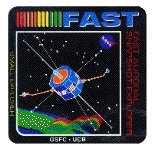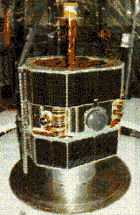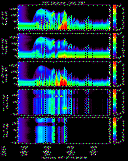A FAST Page for Project SMART
by Chadd Bailey and Ellen Swider

What Is SMART?
Each summer, the University of New Hampshire sponsors Project SMART, an academic program designed for high school sophomores and juniors. Project SMART (Science and Mathematics Achievement through Research Training) is a three and a half week program that provides high school students with the opportunity to explore, in depth, fields of science that are generally not offered in most school curriculums. This year's fields of study were Space Science and Biotechnology. Previous years have included these fields, Environmental Sciences and Marine Biology. Students involved in Project SMART research these sciences, attend statistics and computer classes. The knowledge they have gained is then tied together in the form of a research project or paper.
As members of the Space Science group, we attended daily classes in statistics taught by Greg Reilly, physics, and astronomytaught by Lou Broad and Scott Goelzer. In these classes we learned about our universe, graphing data and rocketry. During one of our most memorable classes, one of our instructors turned a Carbon dioxide (CO2) fire extinguisher into a rocket and propelled himself into a nearby dumpster! On another occasion we constructed our own rockets out of cardboard and balsa wood, painted, and then launched them.
Project SMART is beneficial to students by offering alternative courses and
giving them a taste of college life - particularly that of a graduate student.

What We Did
For the research portion of Project SMART, we collaborated with Dr. Eberhard
Möbius, a physicist and the Project Director, to study the auroral ion beams
found in the Aurora. Dr. Möbius is involved with Plasma Physics and their
relation to Space. On this project, he is focusing primarily on the acceleration
of the particles. Another advisor to us, Dr. Lynn Kistler, also a physicist,
is concerned with how the particles are accelerated and then transported. Her
main interest in the project is what happens to the beams after they are accelerated
from the earth's magnetosphere. Li Tang, a graduate student working towards
his Ph. D. in Physics, was very helpful to us in explaining the processes we
needed to gather our data. We were able to compare our results with some of
his previous work in this project. Eric Lund, a research scientist at the University
of New Hampshire, was very helpful in pointing out where we were incorrectly
reading our data. He also suggested graphing several aspects of our data that
we had not considered before. Eric is currently researching electromagnetic
waves and their use as an energy source.
Some say that the Northern Lights are the glare of the
artic ice and snow; and some say that it's electricity, and nobody seems
to know.
-Robert W. Service
The auroras are a result of activity on the sun and solar wind. The sun discharges
a continuos stream of electrons and ions. These ions, when attracted by the
earth's magnetosphere, circle the earth's radiation belts. They are then accelerated
by this energy into high latitudes where they produce auroral displays.
Our goal was to determine the ion beams' acceleration region, and define
parameters that may affect the location of the region. In order to research
the auroras we analyzed summary data retrieved by one of NASA's Small Explorer
spacecrafts (SMEX), the Fast Auroral SnapshoT explorer (FAST). FAST is a small
satellite which orbits the earth and explores the auroral zones. Launched
on August twenty-first, 1996, FAST has orbited the earth for nearly a year.
The instrument on FAST that we were specifically concerned with was the Time-of-flight
Energy Angle Mass Spectrograph (TEAMS). The information from this satellite
was in the form of graphs, one of which is right below this section. Using
this information, we recorded the date, orbit, Universal Time, altitude, Magnetic
Local Time, and Invariant Latitude of the auroral passages. On the occasions
where we found beams, we recorded the Universal Time, altitude, Magnetic Local
Time, Invariant Magnetic Latitude, duration, and energies of the dominant
ions: H+, He+, He++, and O+. From our research we have concluded many things
about the aurora. For example, there is a definite correlation from the number
and location of the beams we studied to the invariant latitude at which they
occurred. There is still another correlation from the number of beams to the
magnetic local time.
FAST
- Launched August 21, 1996
- Flys at a 400 x 4000km altitude near polar orbit
- Weighs 400 lbs.
- Completes an orbit every 2 hours;12 per day
- Carries 5 instruments
- Time-of-flight Energy Angle Mass Spectrograph(TEAMS)
- Electrostatic Analyzers(ESA)
- Electric Field Experiments(EFE)
- Instrument Data Processor Unit(IDPU)
- Magnetic Field Instrument(MFI)
The FAST satellite. The gray circular object on the right is the
instrument TEAMS.
TEAMS
- Ion Mass Spectrograph
- Dominant Ions Detected: H+, He+, He++,
O+
- Energy Range: 5eV to 12 keV
- Spin Synchronized; 32 or 64 sweeps per spin(mode dependent)
- Field of view: 360o polar angle x 8o
azimuthal angle
- 16 polar angle sectors on 22.5o centers
-
-
Movie about TEAMS
The Workings of TEAMS

This is a sample of some of the data from FAST
-

Who We Are

My name is Ellen Swider(right), and I'm a seventeen year old high
school student from Keene, NH. This fall I will be entering my senior year
at Monadnock Regional High School in Swanzey Center NH. I decided to attend
Project SMART because I wanted to gain some insight on several of my possible
career choices, and explore one of my favorite fields of science, astronomy;
a course that I could never take at school. Project SMART has also sparked
in me, an interest in Physics; a course I look forward to taking this fall.
I plan on using the knowledge I gained at Project SMART for my senior project,
and pursuing these majors in my college career.
I am Chadd Bailey(left), and I am a sixteen year old high school
student entering my Junior year in the fall. I attend Alvirne High School
in Hudson, NH. I am very interested in math and science, and that is why
Project SMART has been good for me. Most of the things I have learned
here I could not have learned at my school because they are not in the
curriculum. Space science has always been interesting to me and this is
the first chance I have had to really learn about it. I am also interested
in computers and I have learned much about them during the past three
and a half weeks.
We would like to thank everyone who helped us with our project, especially
Dr. Eberhard Möbius and Li Tang, both of whom guided us in our search
for the elusive Auroral Ion Beam!! An extra special thank you goes to Kim
Mayer who helped us construct "The Perfect Web Page," gave us numerous extensions
on it, and was extremely patient with us when we decided to "fix it again!!"
Thank you!!

If you want to e-mail us, here are our addresses
Ellen Swider
Chadd Bailey







